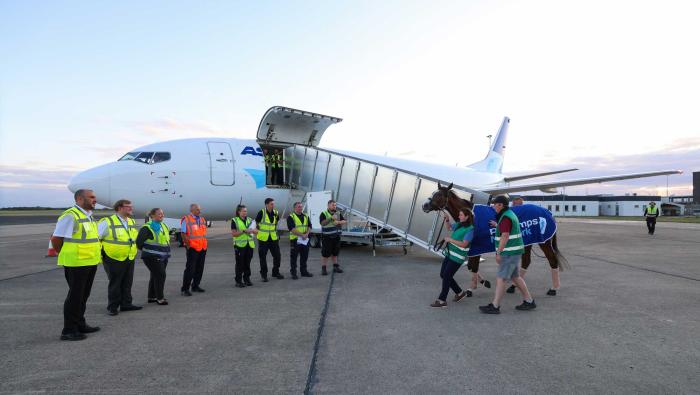
Aviation services provider Jet Access has broken ground on an FBO at John C. Tune Airport (KJWN) in Nashville, Tennessee, with completion expected by year-end. The facility will be the second FBO at KJWN and the company’s second in the Nashville area, joining its location at Music City Executive Airport (KXNX) in Gallatin.
The complex will include a 3,000-sq-ft terminal with executive lounge, private offices, conference room, and refreshment bar, along with an adjoining 22,000-sq-ft hangar capable of housing ultra-long-range business jets.
KJWN features a 6,000-foot main runway and is a gateway to one of the nation’s fastest-growing areas. For the company, the new FBO will be its ninth location in the U.S.
“Nashville represents a strategic home market for Jet Access, and we’re proud to lead the industry as the only company operating across all five major business aviation verticals: maintenance, charter, management, FBOs, and aircraft brokerage,” said company CEO Quinn Ricker. “Establishing our presence at [KJWN] is more than expanding our footprint—it’s about creating an exceptional experience for our clients and partners.”
|
It’s been more than a year since my blog post about Mr. Moneybags and one of his pilots. If you recall, this was a lesson on communicating effectively with C-level executives and high-net-worth individuals. Notably, it points out that an executive with an MBA speaks a different language than a pilot with an ATP.
The core issue from the last conversation focused on controls that the flight department established to safely operate a large corporate jet into a small airfield in the Caribbean. In the end, a concise conversation about risk reduction and decreasing operating expenses put the billionaire at ease.
Last week, I decided to check in with our friend, the corporate pilot, to see how things are going. While it’d be nice to report that everything was smooth sailing, unfortunately, it is not.
Accordingly, in January, Moneybags brought in an old business school classmate to shore up the finances across all segments of the enterprise, including the flight department. All pilot expenses are now heavily scrutinized. Internally, flight department personnel jokingly say these new cost-saving initiatives come directly from the “Department of Pilot Efficiency” (DOPE).
Untouched are the recently delivered Gulfstream G700, a helicopter at a remote island location, maintenance, training contracts, and the multimillion-dollar catering budget. Outside of those items, the entire aviation budget is under a microscope.
|
At the recent DEF CON 33 conference, audio engineer Andrew Logan raised concerns about ATC voice communications. “My nightmare is that a sophisticated attacker might use AI voice-cloning technology to impersonate air traffic controllers and intermittently give false clearances to cross runways, particularly in adverse weather conditions,” Logan said in his presentation.
The problem is that powerful air-band transmitters such as the Motorola CM-400 VT VHF are easily available on eBay for $200. “It’s pretty scary how cheap these things go,” he said. “When paired with an appropriate antenna, it offers an order of magnitude more power, 25 to 45 watts. My fear is that an adversary with that power could transmit much further away from the airfield.”
He added that there is a “plethora” of free or low-cost voice-cloning technology available online and demonstrated how quickly it can clone a controller’s voice during a simulation. “It only gets better the more you feed it,” Logan said. “And it is trivially easy to create a convincing voice clone, particularly when you’re about to transmit it over a radio that’s going to obscure it further.”
Logan has contacted relevant authorities and entities to warn them about voice cloning, including the FAA, ICAO, FCC, U.S. Senate Committee on Transportation, and the National Air Traffic Controllers Association. None has yet responded to his warning, he said.
|
A new report from SkyQuest Technology Consulting predicts the global jet fuel market will more than double over the next seven years. Valued at $351 billion at the end of 2024, the company forecasts this market to exceed $750 billion annually by 2033 due to new joint ventures and large-scale production activities in the sector.
According to SkyQuest’s analysts, the advances in fuel efficiency driven by innovations in aircraft design and engineering will ultimately benefit the aviation fuel market by bringing down costs, which is “beneficial given the rising demand for fuel with lower-carbon emissions.”
As part of their global sustainability goals, airlines and other operators are using sustainable aviation fuel (SAF) to lower their overall emissions. This raises the demand for SAF considerably, in addition to bringing more infrastructure and investment opportunities. Use of renewable feedstocks in SAF production has created new opportunities for neat unblended SAF’s competitive advantages since these resources have been widely marketed, the report added.
The primary hurdle in the expansion of the market is expected to be high fuel cost due to higher crude oil prices, which is rising due to the mismatch between supply and demand, the report said. Because of the weakening global economy and rising interest rates in some Western countries, Saudi Arabia recently curtailed its crude oil production equivalent to 2% of the global supply.
|
Savvy Aviation has introduced an anomaly detection tool that uses artificial intelligence (AI) to augment human-led diagnoses of piston engine problems. The GADFly tool is designed to help identify unusual engine behavior based on analysis of engine data to help owners with data-driven and on-condition maintenance and to advance safety, reliability, and compliance.
According to Savvy Aviation founder and CEO Mike Busch, the company receives about 15,000 flights uploaded to its platform every week, “so obviously we can’t look at all of them. In the past, our analysts only looked at flights that our clients asked us to review. Now with GADfly, we can look at every flight that the AI suggests we look at, and alert clients to issues they didn’t know they had.”
This means that GADFly is “amplifying human expertise,” according to Savvy, “not replacing it. It helps Savvy’s analysts spot flight data patterns or anomalies that may otherwise go unnoticed, without compromising the personal, thoughtful analysis clients expect from the Savvy team.”
The Cirrus SR22 is the first aircraft to undergo the GADFly process, and Savvy plans to add other aircraft models. While Savvy doesn’t yet serve the turbine-powered aircraft market, “GADfly could be trained to work with turbine aircraft,” according to the company.
|
NBAA welcomed the return to zero-for-zero tariffs on civil aircraft and parts under a new U.S.-European Union trade framework that takes effect September 1. The group noted the Framework on an Agreement on Reciprocal, Fair, and Balanced Trade restores balance for an industry long supported by the 1979 Agreement on Trade in Civil Aircraft.
“The agreement marks a vital step toward reestablishing a fair and balanced trade environment,” said NBAA president and CEO Ed Bolen. “It supports continued innovation in aerospace, strengthens the United States’ global leadership in aviation safety, and helps sustain the significant trade surplus that the U.S. aerospace industry has achieved over many decades.”
A joint U.S.-EU statement published yesterday by the European Commission’s directorate general for trade and economic security discussed the framework, underscoring its broader significance. According to the document, the framework is intended as “a concrete demonstration of our commitment to fair, balanced, and mutually beneficial trade and investment,” with provisions designed to expand market access and enhance economic security.
Eliminating duties on U.S. industrial goods entering Europe, the agreement provides expanded market access for U.S. agriculture and seafood. In return, the U.S. commits to limit tariffs on EU goods to no more than 15%, while confirming that as of September 1, aircraft and aircraft parts will be subject only to the most-favored-nation rate.
|
Top Stories This Week on AINonline
|

Photo of the Week
Flying horses. The cargo area at the UK’s Teesside Airport has once again welcomed top championship horses for one of the region’s biggest racing weekends. Six thoroughbreds arrived on Wednesday morning and another two arrived yesterday to compete in the York Races Ebor Festival 2025 this weekend. Minnie Hauk—last year’s winner at this race—was one of the arrivals yesterday. Thanks to the Teeside Airport team for sharing this photo!
Keep them coming. If you’d like to submit an entry for Photo of the Week, email a high-resolution horizontal image (at least 2000 x 1200 pixels), along with your name, contact information, social media names, and info about it (including brief description, location, etc.) to photos@ainonline.com. Tail numbers can be removed upon request. Those submitting photos give AIN implied consent to publish them in its publications and social media channels.
|
AINalerts News Tips/Feedback:
News tips may be sent anonymously, but feedback must
include name and contact info (we will withhold name on request). We reserve the
right to edit correspondence for length, clarity, and grammar. Send feedback or
news tips to AINalerts editor Chad Trautvetter.
|
AINalerts is a publication of AIN Media Group, 214 Franklin Avenue, Midland Park, New Jersey. Copyright 2025. All rights reserved.
Reproduction in whole or in part without permission is strictly prohibited.
|
|















